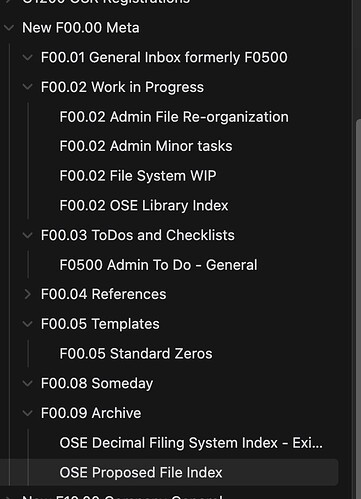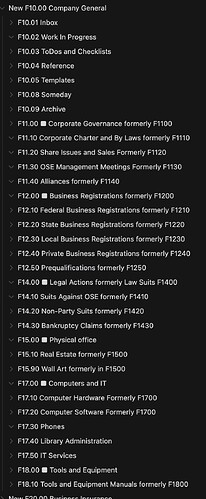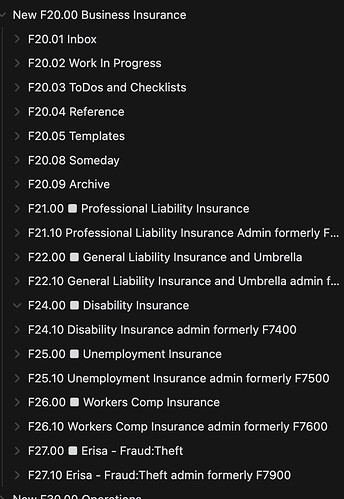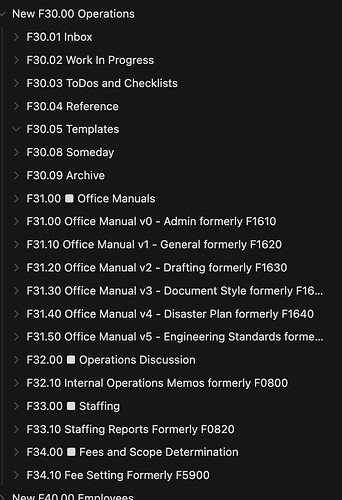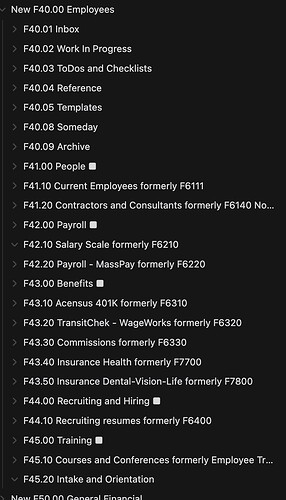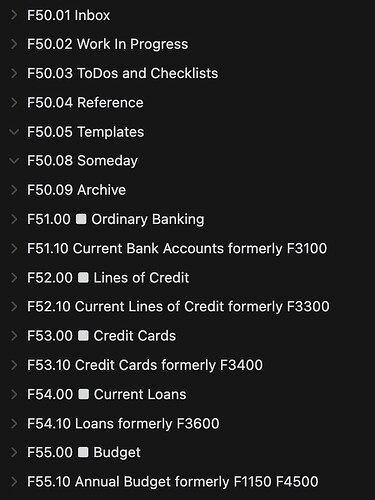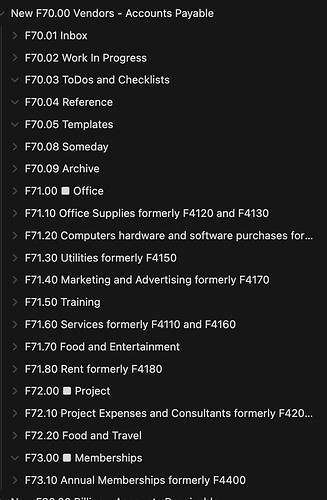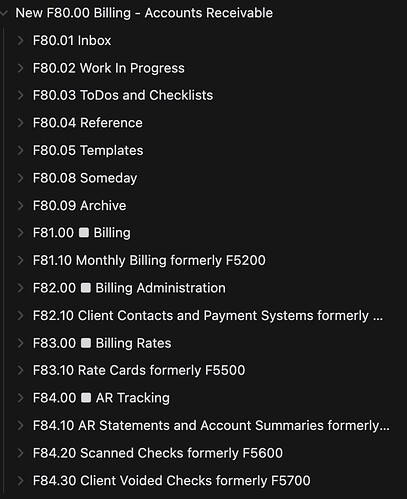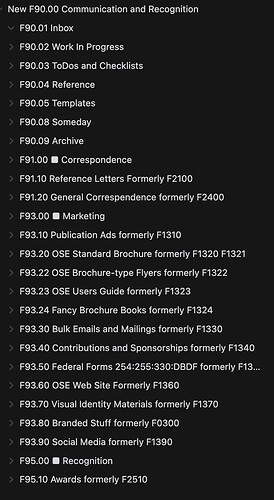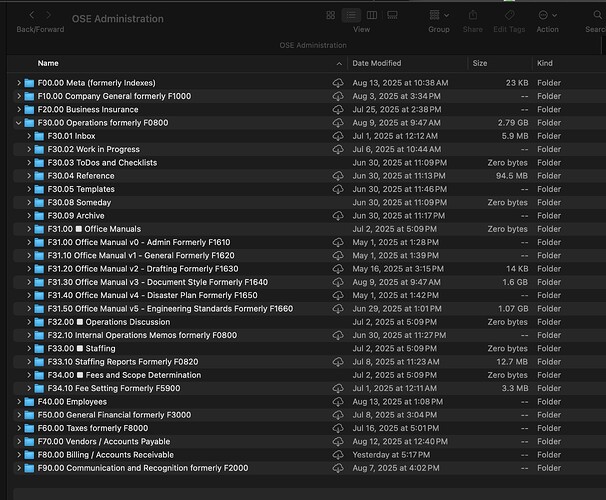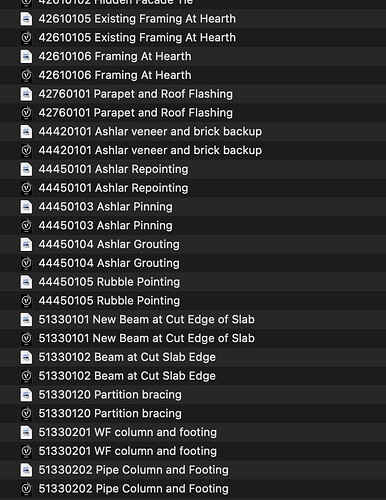A case study of using JD for an existing company with a lot of files.
I mentioned a while back that I was adopting the JD system to my company’s existing files, and that I would explain the result. I’m about to post 800 words and 18 screen caps, so I’ve given up on trying to write a comprehensive description, but will happily answer questions including ones like WHAT IS THAT? and WHY IS IT OOZING?
Our company (Old Structures Engineering, usually abbreviated OSE) is bigger than most - but not all - of the entities represented here discussing JDexing. OSE has 13 full-time employees and three freelancers who work for us part-time when not pursing their own interests. This is reflected in our documents: Our projects have, as of today, over 1,100,000 files; administration is over 85,000 files.
Some general context: we are full hybrid and have been since the spring of 2020. Every employee gets a Mac laptop that we set up, second (and on-request third) screens, mice, keyboards, and a hub for office use, and a budget for buying equipment for home use. Our files are all kept in Box .com and backed up locally.
By coincidence, our project to digitize all of our old paper files and go pure paperless finished in 2019. (Out of the scope of this discussion, but we use Daylite for CRM and calendaring, and that also uses remote servers.)
I started the company in 2007 as a continuation of my existing solo practice, and that has shown up in admin practices: we have had to repeatedly adjust procedures that made sense for one or three people to work with a bigger office. To use admin files as an example, we went from paper with files named by area in 2007, to hybrid paper and server with a primitive decimal+name system in 2012, to a variation on JD in 2025. My hope is that the current system will last for twenty years - until after my retirement.
The system as I’m going to lay it out is not necessarily what I would do if I were starting with a blank page, but we have (via my old practice and my partner’s old practice) project files going back to 1992 and a lot of other still-used files that are almost that old. To quote a line from William Faulkner: The past is never dead. It’s not even past.
The top level is a bunch of numbered series, each prefaced with a letter. Here’s my working note on that:
The Fs, Js, and Ps have been around for a long time. The number of digits in the numbered series (represented by the Xs) is based on categorization that is different for the different series. The As, Js, and Os, for example are simply counting up. There is a number series for building components created by the (US) Construction Specifications Institute; we use a variation on that to distinguish materials for the Ls, Cs, and Ds. This may sound incredibly complicated, but what’s interesting as I’ve been working out years-old knots is that no one seems to have the slightest problem with it. Project numbers have no inherent meaning, while our typical details are numbered by primary material, secondary material, series, and then item number. It seems like people are using different parts of their brains or something, and don’t have problems with this. Of course everything has a name in addition to the number.
Starting with administration, which is our JD-est category…the reference JDex is the folder structure in Obsidian, editable by me and our two admins. Every category gets a folder that will contain any notes; header categories with squares are empty. Here’s the structure, with the notes regarding old number for the transition that’s just about wrapping up now:
(Note that there is a stutter-step in Operations: The admin office manual, which is not distributed to everyone, was developed after volumes 1 through 4 already existed and it seemed to make sense for it to be volume 0 in the series, so it ended up with the same Fxx.xx number as the header. So sue me.)
The Box administration folder has the same structure, of course.
Here’s a piece of the projects folder, which is organized by hundreds and then thousands of projects:
Here’s the overall templates folder, which is the second-most-heavily-used folder after projects:
Here’s template used to create new projects (on average, a daily event). Note that the subfolder numbers are only there to enforce sorting in the finder:
Here’s a piece of the CAD templates folder, which has 600 details:
And here’s our a piece of library’s index in Zotero
Note that the library is about 4000 items in paper, roughly half of which we also have PDFs of, and about 5000 items in PDF only. Since Zotero stores PDFs, we scan the title page of books, or first page of other paper documents, and store them the same we we store the paper items. If you go looking for something in the library and find just the title page, you have to walk over to the shelves.
Incredible, thanks for sharing!


